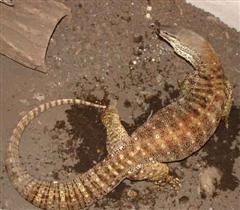Monitor - Argus
Scientific Name: Varanus panoptes horni
Sat, 12th July, 2025 - 5:21 am GMT
Sponsor Ads:

Alternative Name
Scientific Name: Varanus panoptes horniBasic Info
The Argus Monitor is smaller than many of the other monitor species. In addition to its interesting behavior, its size makes the Argus very popular among hobbyists. Argus monitors can grow to about 3.5 to 5 feet. The males tend to grow larger than the females. Most Argus Monitors are black or near black with light colored (usually tan to yellow) markings that run along their backs, continuing along the length of their tail. The face of the Argus also has some beautiful markings. The Argus Monitor's head is described as triangular shaped. Their limbs appear proportionately larger than those of other monitor species and are equipped with sharp claws. Their tails are also very muscular and heavy.
Health
N/AHabitat
Found near rivers and streamsBehavior
The Argus Monitor is a colorful monitor that is becoming quite popular among monitor lovers worldwide. The Argus Monitor is perhaps best known for its habit of standing on its back legs. This behavior has often been described as ferret-like in appearance. This behavior is also known as "tripoding" since they use their tails as a "third leg" to aid them in balancing. The Argus Monitor has been described as mammalian-like with some of its other behaviors as well. The Argus Monitor is described as highly intelligent. They are known for being exceptionally curious, "tripoding" to observe their surroundings and exploring everywhere they can. Unlike many reptiles the Argus is often described as social, forming pair bonds in the wild. The female Argus Monitor will only mate with her chosen male, though the male does not share this bond. It is also said these monitors will form social bonds with their siblings that are maintained throughout their lives. In captivity, adult males and adult females do not tend to adjust well to other adults of the same sex. Some may perceive the Argus monitor as aggressive; however, they tend to appear more aggressive than they are. In fact, in most cases they Argus Monitor will put on many behavior displays when frightened, rather than bite. Generally speaking, the Argus Monitor is one of the least aggressive of all the monitors. In the wild the Argus Monitor will usually run from confrontation, and they can move at rapid speeds. If they are forced to defend themselves, both in the wild and in captivity, their primary method of defense will be physical displays. They will begin to tripod and puff themselves up by distending their throats. In addition they will make loud hissing noises. If the threat continues, they will often open their mouths widely and lunge at the perceived threat. If, in spite of all of this, they are grabbed they will then try to claw, bite, or defecate on their assailant, while struggling to be released. These are very strong lizards with sharp teeth. Like most reptiles, early and consistent handling will help to ensure your Argus Monitor will respond well to human interaction, but most will never be content to be held for long periods of time. They are very curious and will usually prefer to climb on you exploring your entire body, this may or may not be desirable. Most keepers describe the Argus as fairly high strung, particularly when young, but this is not necessarily a bad thing. Many hobbyists maintain that it is their active behavior that makes them one of the most interesting monitors to keep and observe. The Argus Monitor likes to dig, climb, and burrow both in the wild and in captivity.Origin
Australia and New GuineaHistory
The Argus Monitor is native to Northern Australia and the topical island of New Guinea. The Argus Monitor is a diurnal lizard that is often found near rivers and streams, but they are not restricted to any particular microhabitat.Common Foods
N/ASponsor Ads:
"I never let my schooling get in the way of my education." -- Mark Twain
Monitor - Argus
Coded by: BGID® | ALL RIGHTS RESERVED Copyright © 2000-2025
Disclaimer | Privacy | Report Errors / Contact | Credits








 Preparing For China. China is growing their military. China Military Technology - can it keep up with the US?
Preparing For China. China is growing their military. China Military Technology - can it keep up with the US?  versus
versus 

 versus
versus 
 This Thread is about the North Korean Military itself - the kind of army, navy, and air force they have.
This Thread is about the North Korean Military itself - the kind of army, navy, and air force they have. 
 versus
versus 
 versus
versus  versus
versus